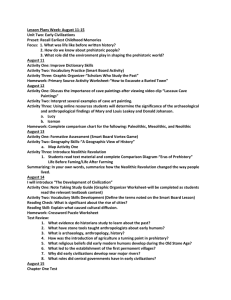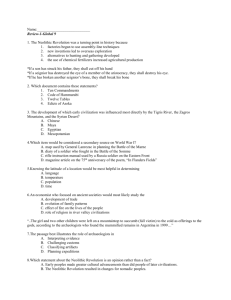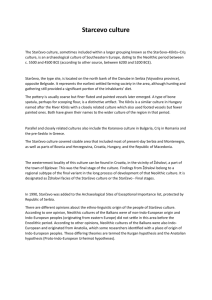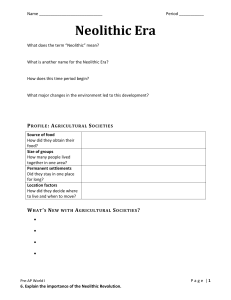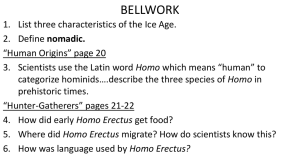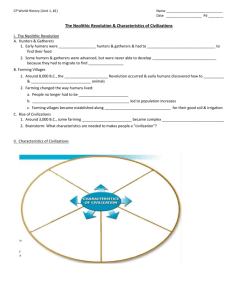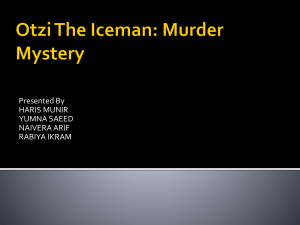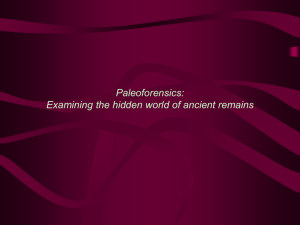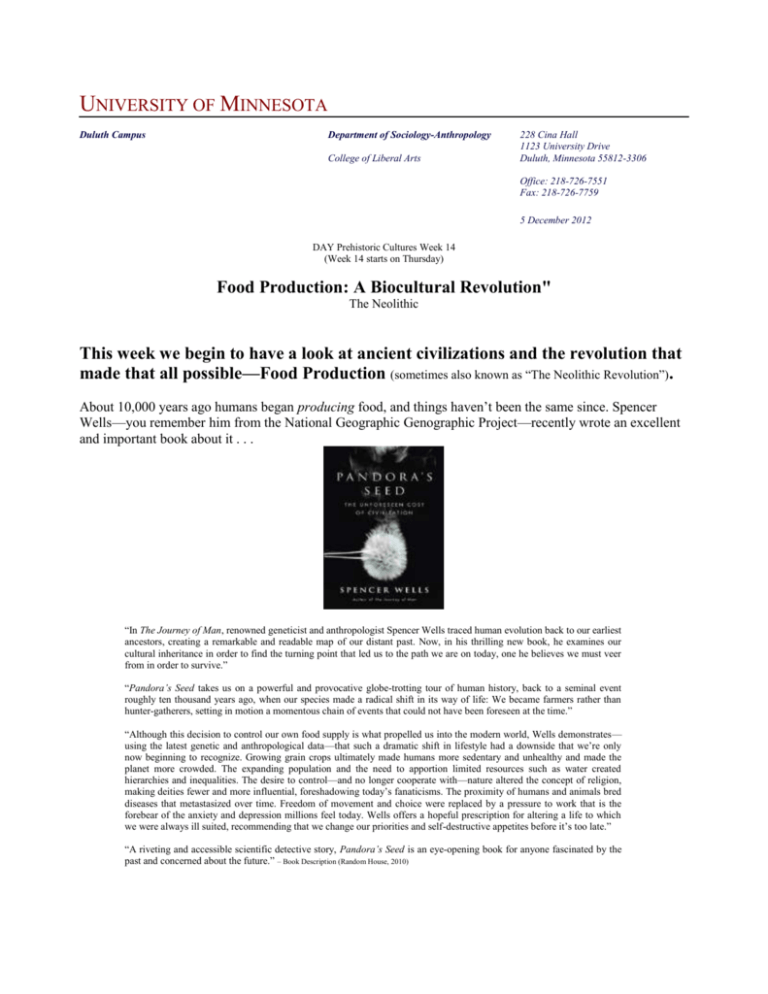
UNIVERSITY OF MINNESOTA
Duluth Campus
Department of Sociology-Anthropology
College of Liberal Arts
228 Cina Hall
1123 University Drive
Duluth, Minnesota 55812-3306
Office: 218-726-7551
Fax: 218-726-7759
5 December 2012
DAY Prehistoric Cultures Week 14
(Week 14 starts on Thursday)
Food Production: A Biocultural Revolution"
The Neolithic
This week we begin to have a look at ancient civilizations and the revolution that
made that all possible—Food Production (sometimes also known as “The Neolithic Revolution”).
About 10,000 years ago humans began producing food, and things haven’t been the same since. Spencer
Wells—you remember him from the National Geographic Genographic Project—recently wrote an excellent
and important book about it . . .
“In The Journey of Man, renowned geneticist and anthropologist Spencer Wells traced human evolution back to our earliest
ancestors, creating a remarkable and readable map of our distant past. Now, in his thrilling new book, he examines our
cultural inheritance in order to find the turning point that led us to the path we are on today, one he believes we must veer
from in order to survive.”
“Pandora’s Seed takes us on a powerful and provocative globe-trotting tour of human history, back to a seminal event
roughly ten thousand years ago, when our species made a radical shift in its way of life: We became farmers rather than
hunter-gatherers, setting in motion a momentous chain of events that could not have been foreseen at the time.”
“Although this decision to control our own food supply is what propelled us into the modern world, Wells demonstrates—
using the latest genetic and anthropological data—that such a dramatic shift in lifestyle had a downside that we’re only
now beginning to recognize. Growing grain crops ultimately made humans more sedentary and unhealthy and made the
planet more crowded. The expanding population and the need to apportion limited resources such as water created
hierarchies and inequalities. The desire to control—and no longer cooperate with—nature altered the concept of religion,
making deities fewer and more influential, foreshadowing today’s fanaticisms. The proximity of humans and animals bred
diseases that metastasized over time. Freedom of movement and choice were replaced by a pressure to work that is the
forebear of the anxiety and depression millions feel today. Wells offers a hopeful prescription for altering a life to which
we were always ill suited, recommending that we change our priorities and self-destructive appetites before it’s too late.”
“A riveting and accessible scientific detective story, Pandora’s Seed is an eye-opening book for anyone fascinated by the
past and concerned about the future.” – Book Description (Random House, 2010)
Prehistoric Cultures, Week 14, p. 2
Pandora’s Seed is a good evaluation of the consequences of the agricultural revolution and the resulting
subsequent rise of civilizations.
On Tuesday we’ll have our own in-class evaluation. Our IT folks have also sent you one on-line. Please
complete both of them carefully and thoughtfully as they are very important to this class, and to the
Department and College.
And, for the most part, it was agriculture that made civilization—living in cities—possible.
The word civilization comes the Latin cīvitās, referring to people who constituted a city-state—the citizenry
of a town or city. Civilisation in the 18th century was contrasted with wild—sauvage in French—setting up
the well-known comparison “civilized” and “savage” which really meant living in the wild—that is,
hunting/gathering/foraging—vs. living in the city.
And, as I mentioned, that changed almost everything—at least for the city folks.
We’ll have a look at the “Agricultural Revolution,” known as “The Neolithic Revolution” in the Near East,
and we’ll have a look at a couple of the early city-state civilizations, with the video "Wisdom of the Stones:
Life in the Neolithic Age" (Part 1 of Secrets of the Stone Age Series).
"In this program, anthropologist Richard Rudgley strives to roll back the limits of history to include the remarkable
achievements of the Neolithic Age. Engineering skills, as demonstrated by the temple of Hagar Qim and the Hal Saflieni
Hypogeum, in Malta; indications of well-developed religious systems; evidence of acupuncture techniques; examples of
bookkeeping via clay tokens; and proof of an intricate social structure through the digs at Çatal Höyük and Asikli Höyük, in
Turkey, reveal the depth and the genius of the Neolithic peoples. Architect Richard England, writing specialist Denise Schmandt
Besserat, and others support Rudgley’s thesis with expert analysis."
Prehistoric Cultures, Week 14, p. 3
Of course the most famous Neolithic person is "Ötzi" “The Iceman”
<http://www.d.umn.edu/cla/faculty/troufs/anth1602/video/Ice_Man.html#title>. We’ll see the most recent film on Ötzi—Iceman Murder Mystery
(NOVA October, 2011)—emphasized his life as a person living in the transitional times going from
hunting/gathering/foraging to early agriculture, based on the most recent analysis of the contents of his
stomach . . .
“He’s been dead for more than 5,000 years and poked, prodded, and probed by scientists for the last 20. Yet Ötzi the Iceman, the
famous mummified corpse pulled from a glacier in the Italian Alps, continues to keep many secrets. Now, through an autopsy
like none other, scientists will attempt to unravel mysteries about this ancient mummy, revealing not only the details of Ötzi’s
death but also an entire way of life. How did people live during Ötzi’s time, the Copper Age? What did they eat? What diseases
did they cope with? Join NOVA as we defrost the ultimate time capsule—the 5,000-year-old man.”
If you want, you can watch the video
Iceman Murder Mystery
online
(NOVA October, 2011)
Iceman Murder Mystery HomePage
Forum this week we’ll also have a look at Ötzi . . .
In the
Forum: What's Really New with Ötzi The Iceman? (Due by Friday, 14 December 2012)
As usual, if you have any questions, please let me know: mailto:troufs@d.umn.edu. Or, better yet, post them on you
Discussion and Project forum boards. Share your ideas. Discuss them on-line with the others in class
...
f2012 DAY 1601
Live chat for Project Collaboration
General Student Discussion Area Forum
The above items will be found at the top of your
folder under “Student Collaboration Space.”
Your
Topics and Reading Assignments Listings for Week 14 will look something like the
information below.
Best Regards,
Tim Roufs
Week 14 —Food Production: A Biocultural Revolution"
The Neolithic
(Week 14 starts on Thursday)
DAY Week 14 Memo
Prehistoric Cultures Extra Credit papers are due Friday, 7 December 2012
AVISO: Late Extra Credit Papers will not be accepted unless (1) arrangements for an alternate date have been
arranged in advance, or (2) medical emergencies or similar extraordinary unexpected circumstances make it
unfeasible to turn in the assignment by the announced due date.
~
Prehistoric Cultures, Week 14, p. 4
Food Production and the Rise of Ancient Civilizations: The Neolithic
Food Production: A Biocultural Revolution
slides: (.pdf) (.pptx)
The First Civilizations
slides: (.pdf) (.pptx)
New World Civilizations
slides: (.pdf) (.pptx)
~
course evaluation
(DAY 28: Tuesday, 11 December 2012)
Anth 1601 - 001
Course Call # = 32646
Semester
= 3 Fall
Year
= 12
~
DAY 27 Thursday, 6 December 2012 nlt 3:54
video:
"Wisdom of the Stones: Life in the Neolithic Age"
part 1 of Secrets of the Stone Age Series
(51 min., 2000, VC 3906, pt. 1)
course viewing guide
Prehistoric Cultures, Week 14, p. 5
Mother Goddess
Hagar Qim, Malta
Malta HomePage
Bronze Age: 2,200 B.C.
Copper Age: 3,300 B.C.
Neolithic: 8,000 - 3,000 B.C.
("Wisdom of the Stones")
~
DAY 28 Tuesday, 11 December 2012 nlt 3:39
video:
The Iceman Murder Mystery
(60 min., 2011, UM Duluth Library Multimedia GN776.22.I8 I24 2011 DVD)
Ötzi—The Iceman -- South Tyrol Museum
Prehistoric Cultures, Week 14, p. 6
Bronze Age: 2,200 B.C.
Copper Age: 3,300 B.C.
Neolithic: 8,000 - 3,000 B.C.
("Wisdom of the Stones")
DAY 29 Thursday, 13 December 2012 nlt 3:35
video:
*"The Collapse"
from the Out of the Past series
(60 min., 1993, VC 2135)
* time permitting
course viewing guide
*Presentation depends on time available
As you view the videos over the remainder of the semester
pay attention to . . .
1.
the actual content of the various finds
2.
archaeological field methods and techniques
3.
laboratory methods and techniques
o
4.
including reconstruction techniques, and
...
archaeological dating techniques
Prehistoric Cultures, Week 14, p. 7
5.
theoretical / interpretative approaches
o
including logic of analysis
More information on methods is contained in the text and in
the methods slides:
Archaeological Methods and Dating Techniques
WebPage
Some Important Concepts
(slides 11B)
Special Skills:
In the Field (slides 10A)
In the Lab
(slides 10B)
In the Field and Lab
(slides 10C)
Archaeological Dating Methods
Other Methods of Analysis
(slides 10D)
(slides 10E)
For Week 14 Activities see
readings from Understanding Humans, 11th Edition
Ch. 15, "The First Civilizations," pp. 373-406
assignment:
Review for Final Exam
Prehistoric Cultures, Week 14, p. 8
Final Exam information
is available at
<http://www.d.umn.edu/cla/faculty/troufs/anth1602/pcexamsTR.html#final>
Click on the various items for details
Review the materials
in your text
in your class notes
and on the
DAY video viewing guides
or
Useful Information:
UMD Study Strategies
Test Taking Strategies
Prehistoric Cultures, Week 14, p. 9
Learning Styles
Listening Skills
Taking Notes from Lectures
Special Facilities / Arrangements
Basic Information about the text
Writing Essays for Exams
(Purdue University Online Writing Lab)
Sample Exam Questions: Final
extra help with exams
Prehistoric Cultures Extra Credit papers are due Friday, 7 December 2012
AVISO: Late Extra Credit Papers will not be accepted unless (1) arrangements for an alternate date have been
arranged in advance, or (2) medical emergencies or similar extraordinary unexpected circumstances make it
unfeasible to turn in the assignment by the announced due date.
For Week 14 Activities see
© 2011-2013 Timothy G. Roufs — All rights reserved


